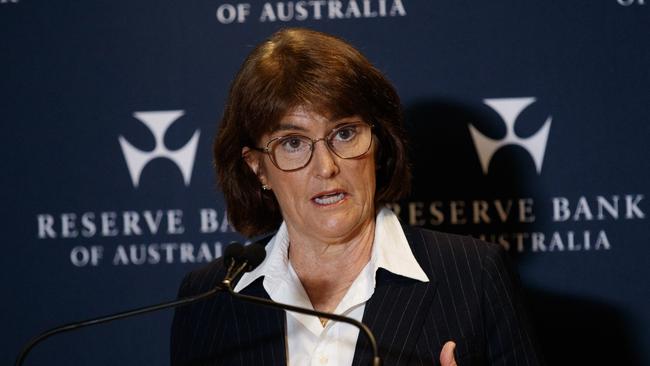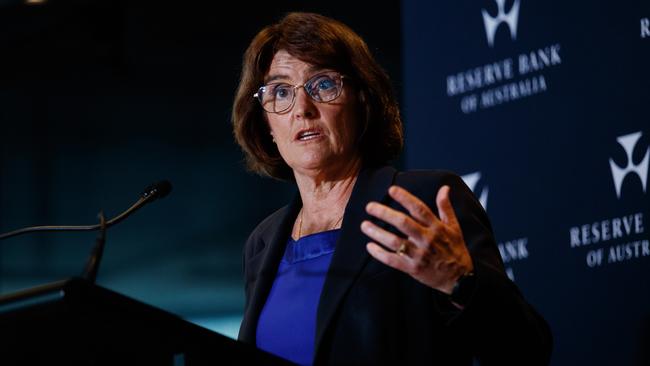RBA stuck between inflation, growth risks but will cut interest rates again
The Reserve Bank is now stuck between supporting the economy and managing inflation risks but will ultimately prioritise growth and cut rates again, potentially as soon as July.

The Reserve Bank is stuck between supporting the economy and managing inflation risks but will ultimately prioritise growth and cut rates again, potentially in July, economists say.
While affected by cyclones, heavy rainfall and flooding along the east coast, Australia’s quarterly economic growth slowed significantly from 0.6 per cent in the December quarter to 0.2 per cent in the March quarter amid subdued growth in underlying consumer spending and business investment.
Economic growth undershot economists’ forecast of 0.4 per cent for the March quarter and the RBA’s most recent forecast of 0.45 per cent per quarter over the first half of 2025.
“In line with our updated expectations, public demand fell, and the private sector struggled to pick up the slack,” said Westpac senior economist Pat Bustamante.
“While one-off factors, mainly related to bad weather events in Qld and NSW, played a role, underlying momentum is undoubtedly weak.
“This likely reflects the ongoing squeeze on some households from restrictive interest rate levels and caution in the face of US President Trump’s tariff war and associated financial market volatility.”

Citi Australia chief economist Josh Williamson said growth was weaker than expected due to a smaller positive contribution from inventories and negative public sector spending.
He doubts the RBA’s forecast of 1.8 per cent on-year growth for the June quarter will be achieved, as it would require a heroic 0.7 per cent on-quarter increase for the June quarter.
“Households and businesses appear more cautious because of global developments and further poor weather could continue to dampen tourism and also rural production, mining and shipping,” he said.
“These developments would support a July RBA rate cut.
“However, household incomes are rising solidly from a mix of strong employee compensation and government and insurance disaster support and productivity data continues to go in the wrong direction.
At the margin, Mr Williamson expects the next cut in August, but added the RBA may act sooner, “fearing a weakening labour market and CPI that undershoots the midpoint of the target band.”

Excluding the Covid-19 period, it was on a par with the weakest reads since the early 1990s recession.
GDP per person fell 0.2 per cent on-quarter and 0.4 per cent on-year after stabilising in the last three months of 2024.
Corporate profits fell 0.5 per cent on-quarter versus market expectations of a 1.3 per cent rise.
Westpac said weather-related disruptions to coal production probably drove a 6 per cent on-quarter fall in mining profits during the quarter. Together with the easing in commodity prices over recent years, mining profits were down 19 per cent on-year. But corporate profits outside the mining sector were more constructive, rising 6.2 per cent on-year.
Economists now warned of a period of subpar economic growth if the handover from the public to the private sector is shaky. This risk is being exacerbated by global uncertainties relating to US trade policy, which has weighed on confidence and the willingness to invest and spend.
The latest blow in the global trade war came Wednesday when US President Donald Trump went ahead with a doubling of US tariffs on steel and aluminium imports to 50 per cent.
At the same time, Australia’s labour productivity fell 1 per cent on-year, and growth in the economy’s cost base, or nominal unit labour costs, remained elevated at 6.1 per cent.
“This leaves policymakers stuck between supporting growth and managing inflation risks,” Westpac’s Mr Bustamante said.
Market pricing on the chance of the RBA delivering another 25 basis point interest rate cut at its next meeting in July crept up to 81 per cent from 74 per cent before the national accounts data.
The local stock market was having its best day in five weeks after the national accounts data.
The ASX 200 share index rose as much as 0.9 per cent to a multi-month high of 8546.5 points.
State Street Global Advisors APAC economist Krishna Bhimavarapu said Australia’s disappointing March quarter GDP data showed that the Reserve Bank kept interest rates restrictive for too long.
“Today’s GDP growth data came in below our low bar 0.3 per cent on-quarter forecast,” Mr Bhimavarapu said. “It’s three times slower than what we pencilled in March.
“This changes the fundamental approach to the Australian economy, as the RBA may ease faster and potentially by larger magnitude when they meet next.
“Either way, the data settles the debate that the cash rate remained restrictive for longer than perhaps needed and that growth is affected as a result.”

Goldman Sachs Australia chief economist Andrew Boak saw a strong case for the RBA to cut interest rates again by 25 basis points in July after the latest national accounts data showed late 2024 pick-up in economic growth looks to have faltered in the March quarter. He said it cast doubt on the RBA’s recently downgraded forecast of a consumer-spending led rebound in economic activity.
“Looking ahead, a substantial RBA easing cycle will be required to spur a sustainable growth into private demand in our view, given the budgeted slowing in spending on aged care and the NDIS will continue to erode the tailwind to growth from the public sector, a substantial easing cycle will be required to spur a sustainable rotation of growth into private demand,” Mr Boak said.
“We see a strong case for the RBA to cut again in July, particularly given inflation has returned to target and a 50 basis points reduction was considered in May.
“Further ahead, our base case is for cuts in August-November to a terminal rate of 3.1 per cent, but we see the risks as skewed firmly to the downside.”
However, Capital Economics ANZ economist Abhijit Surya said a key sticking point was that, “with productivity remaining in the doldrums, unit labour cost growth remains elevated.”
Unit labour costs growth is “too high to be consistent with the Bank’s 2-3 per cent inflation target.”
“Moreover, with the April CPI indicator and business surveys both pointing to a resurgence in underlying inflation, the Bank can ill afford to dismiss upside risks to inflation,” he said.
“The upshot is that we’re sticking to our view that the RBA will only cut rates to 3.35 per cent, above the terminal rate of 2.9 per cent that markets are pricing in.”






To join the conversation, please log in. Don't have an account? Register
Join the conversation, you are commenting as Logout